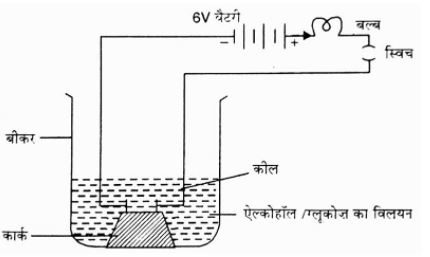NCERT Solutions for Class 10 Science Chapter 2 Acids, Bases and Salts PDF Download
NCERT Solutions for Class 10 Science Hindi Chapter 2 Acids, Bases and Salts
FAQs on NCERT Solutions for Class 10 Science Hindi Chapter 2 Acids, Bases and Salts
1. Why should curd and sour substances not be kept in brass and copper vessels?
We know that curd and sour substances are acidic in nature. When we store them in metal containers like brass or copper the acid reacts with the metals to produce hydrogen and gas. This reaction corrodes the food substance and makes it unfit for consumption. Hence, we should not store sour substances in copper or brass vessels. You will cover more interesting facts about acids, bases, and salts we see in our daily lives in 10th Grade Science: Chapter 2.
2. List out the concepts discussed in Chapter 2 of NCERT Solutions for Class 10 Science.
The NCERT Solutions for Class 10th Science Chapter 2 covers topics like properties of acids, bases, and salts, their reactions with metals, non-metals, and with each other, and several discoveries, along with experiments to back their chemical nature. The chapter also encompasses various experiments like litmus paper tests and facts that are relevant to our day-to-day life. Hence, the course structure makes it exceptionally important and fun from the perspective of board examinations.
3. Fresh milk has a pH of 6. How do you think the pH will change as it turns into curd? Explain your answer?
The pH is used to measure the acidic or basic nature of water. The pH range is from 0 to 14 and the midpoint-7 is neutral. In the Chapter Acids, Bases, and Salts, the properties of acids state that their pH value is less than 7. The higher the acidic nature of a substance the lower is the pH value. Hence, when milk turns into curd, which is more acidic in nature, the pH value decreases.
4. Are the NCERT Solutions for Class 10 Science Chapter 2 the best reference guide for the students?
Acids, bases, and salts is an important Chapter in Class 10th Science. Therefore, making it essential for the students to have a deeper understanding and clarification of the concepts. NCERT Solutions for this chapter provide the students with a comprehensive explanation of the topics and answers to all the questions in the exercises. Hence, they are the best reference guide for exam preparations. They aid you in learning, practicing, and self-evaluation, all in one.
5. Are NCERT Solutions for Class 10 Science Chapter 2 available in Hindi?
At Vedantu’s official website (vedantu.com) and the app, you will find NCERT Solutions for Class 10th Science in both Hindi and English. You can refer to these solutions online and download the PDF free of cost for easy access. These solutions have all the study material you require for your exam preparations. They are curated by professionals keeping in mind the standard and guidelines provided by CBSE Board. Therefore, the solutions are an extremely reliable source for reference.




















 Watch Video
Watch Video















